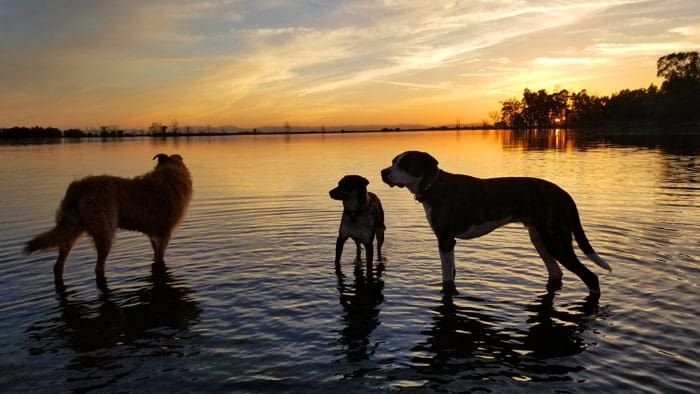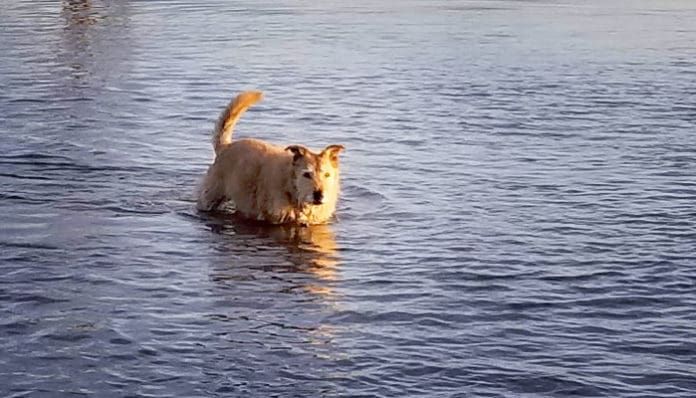There are many global environmental disasters that I am concerned about in a big-picture way, but at this time of year, the one that I am personally and most immediately afraid of on behalf of my dogs has to do with harmful algal blooms (HABs), also known as toxic blue-green algae.
When certain types of algae experience a sudden burst of growth, they can produce toxins that effectively poison the water. Animals that drink the water, inhale water droplets, or swim in the water and lick themselves later can all become sick and die from these toxins.
Staying Away Our Favorite “Watering Hole”
The town I live in has a good-sized river running through it, the Feather River, an integral component of the California State Water Project. The river flow is actually split into two halves, with half the water flowing through the center of town in the river’s historic bed, and half flowing through a canal into two shallow man-made lakes, referred to locally as the Forebay and Afterbay. There are thousands of acres of open space on either side of the river, and even more acres of land surrounding these lakes – and this is where, for 13 years now, I have been walking and swimming with my dogs. Year-round, we walk in these open spaces, referred to as the Oroville Wildlife Area, and my dogs drink, wade, and swim, no matter what the weather.

But late this summer, as in the past couple of years, there have been warnings about toxic algae keeping me away from our favorite places to cool off.
There are a few small ponds in the Wildlife area that turn brilliant green late in the summer – and I have avoided those areas like the plague; that just makes sense. Also, there are a few places on the edges of the lakes that are particularly shallow and the water is still; it’s never turned the bright green that often indicates a HAB, but it starts looking greener than normal. When I see this, I leash the dogs and we walk on until we get to places where the water looks clear.
It’s Not Just Obviously Green Water
But just this past week I read about a family who lost four of their five dogs after the dogs drank and swam in a pond on their farm in Michigan – a pond whose water looked perfectly clear! The toxin in that case was found in the mud at the bottom of the pond.
And last week, the major newspaper published in our state Capital, the Sacramento Bee, ran an article about how quickly HABs can bloom, and how quickly they can kill dogs (and small children!) who ingest the water – and how the conditions are just right for these blooms to occur in local waterways.

This has me avoiding our regular walks, taking them only to places where there are no natural water sources (carrying lots of water for them to drink instead), and only taking them to parts of the river where the flow is vigorous. I miss our favorite places, but won’t take a chance with this!
We’ve run articles about toxic algae before, here and here. Please read, and know what to look for when out walking with your dogs near water!
Additional Reading
For more information about HABs, see these sites:
https://www.cdc.gov/habs/be-aware-habs.html
https://www.cdc.gov/habs/ohhabs.html
https://www.noaa.gov/what-is-harmful-algal-bloom






Scary article. How can you tell if your dog is affected?
Your dog will look as though they have ingested a neurotoxin. They become confused and with an unbalanced, staggering gait. You need to take them to the vet right away. Don’t wait.
This is a very scary time of year. I’m in the Midwest and late August/early September is the driest time of year. With little to no rain, along with bright sunshine, the algae becomes a big problem. Beware of stagnant water in lakes, rivers and streams.
Great advice Susan; especially since you don’t always see visible signs of this toxic bacteria!! Better to be safe than sorry with our beloved pups!
Is there a way we can tell when it’s safe again?
No one mentions all the shots the Vets want us to have for our dogs. DCM related? Secondly why is it so hard to find dog food with grain? I would like to integrate grain with no grain.